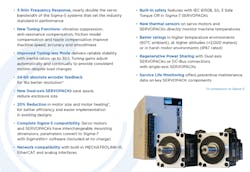Next Generation Servo System Brings Revolution in Motion Control
Since its first release in the early 1990s, Yaskawa America has been on the front line of motion control. Their Sigma Series servo systems have become a staple in high precision operations, and have evolved with every new iteration to bring ever more intelligence, detail, and smoother functionality to critical motion control jobs.
Now that evolution has taken what appears to be a major jump forward with the new Sigma-7 Series, which boasts a list functionality improvements over the previous system. The upgrades seem almost impossibly big for a one-generation leap.
According to Yaskawa, the system nearly doubles the bandwidth of the Sigma-5, offering 16 times the industry standard precision and enough on-board intelligence to drive out just about any machine imperfection or errors it encounters. And it crams all of this into a body 20% smaller than the last version.
As previously stated, it's an impossible big leap, and one we felt warranted a closer investigation.
So we met up with Scott Carlberg, Senior Product Marketing Manager, Servo Products, at Yaskawa America to find out how they pulled off this innovative feat and what exactly all of these new features and functions will mean to manufacturers and machine builders.
NED: These are, to put it mildly, significant improvements over the Sigma-5. How were you able to do this?
CARLBERG: Number one, it's the electronics. There is a lot more processing power with this new generation that roughly doubles the processing power of the previous generation. Then you couple that with better feedback resolution.
With the additional information coming back from the motor and the ability to process the information a lot faster, you're able to do a lot of things within the servo system that results in a lot higher performance, a lot higher machine performance, a lot higher level of machine efficiency.
It also makes the system a lot easier to use.
NED: What does all of this mean in terms of actual performance?
CARLBERG: If you're making a string of moves you’re going to be able to get in and out of them quicker. With all servo systems, as you're following the commanded move you're kind of fluctuating above and below where your commanded position is supposed to be. If you have higher processing power and more data coming back, that window of fluctuation shrinks down to a lot smaller than it ever has been in the past. And so you're not putting the stresses on the mechanics of your system as much as you may have been doing previously with an older technology. That means you're going to have a lot smoother motion across your move. The whole mechanics of your system is going to be quieter and smoother. You're going to be able to get in and out of moves quicker, which means your tact time for whatever operation you're doing can be decreased. NED: We write a lot about machines that fit into what we call, "smart manufacturing"—basically, hardware that is enhanced and improved by software. The physical piece of the Internet of Things. Does this fall into that category of tool?
CARLBERG: I think so. There is a lot of information that you can pull out of the system that really fits into the realm of the Internet of Things.
For example, you can pull out temperature of the motor and the key component of the amplifier. Say you when you originally install your machine and you are running it with your basic machine move profile, you take your motor temperature and then six months later you pull that temperature again and it's 25° hotter. That might lead you to believe that on that particular axis, you might have some kind of mechanical issue that you might want to take care of.
That's just an example of the information you can get out of a system to help you predict things that might be happening on your machine.
There's another example of that is there is a FFP analyzer, a frequency analyzer in the software that will allow you to take a snapshot of the frequency plots that show all of the different resonances that are happening, all of the natural frequencies that are happening with your machine.
Over time, that plot can change and, based on the way it changes, you can equate that to different changes in mechanics or failures in mechanics. Again, you can use that type of information to predict what's happening, what's going to happen on your machine over time, and then you can compensate for that.
That gives you less down time and more efficient operations.
There are a ton of tools in this system that will definitely help on that end of things.
NED: What part of these improvements is software driven versus hardware? Or is it an even mix?
CARLBERG: It's a little bit of both. Really, for the hardware, it comes down to the microprocessor that is on the amplifier and it gives you the ability to process information quicker. That gives us the ability to design more software functionality because we have that extra power, that extra muscle.
We've been able to design a lot of software solutions to make things easier based on that hardware power.
NED: What kind of software solutions does it include?
CARLBERG: One really nice thing is that there is what we call a tuning-less function in the amplifier. With Sigma 7, the system automatically tunes itself based on a load inertia that is anywhere between one and 30:1 load iteration to motor inertia mismatch. Every time the servo scans the feedback device, the amplifier adjusts the tuning gains based on the load inertia on that given movement in time. A lot of times, machine builders will spend a week or two fine tuning a machine before they ship it out. What this allows you to do is not have to worry about the tuning at all. You hook the thing up and it tunes itself automatically and it continuously tunes itself. Whatever is happening on your machine, the system compensates automatically. NED: You mentioned earlier that the system is easier to use. How exactly?
CARLBERG: A lot of our customers have limited resources from an engineering standpoint and even fewer resources that really understand motion control.
This means you can optimize a machine control system without needing a lot of motion control knowledge.
Most of the functionality we have now works automatically in the background and you basically go through a set up wizard that gets you 90% to completion just from the initial setup. You can do some little tweaking, but essentially the system takes care of itself and you're getting a lot higher performance out of it than you would for a lot of the other products that are out on the market.
You don't have to have specialists that really have to understand. We understand it and we've incorporated it all into the product so you don't have to worry about it.
About the Author
Travis Hessman
VP of Content, Endeavor Business Media
Travis Hessman is the VP of Content for Endeavor Business Media. Previously, Travis was the Editor-in-Chief for Industry Week and New Equipment Digest as well as the Group Editorial Director for Endeavor's Manufacturing Group.
He began his career as an intern at IndustryWeek in 2001 and later served as IW's technology and innovation editor. Today, he combines his experience as an educator, a writer, and a journalist to help address some of the most significant challenges in the manufacturing industry, with a particular focus on leadership, training, and the technologies of smart manufacturing.


